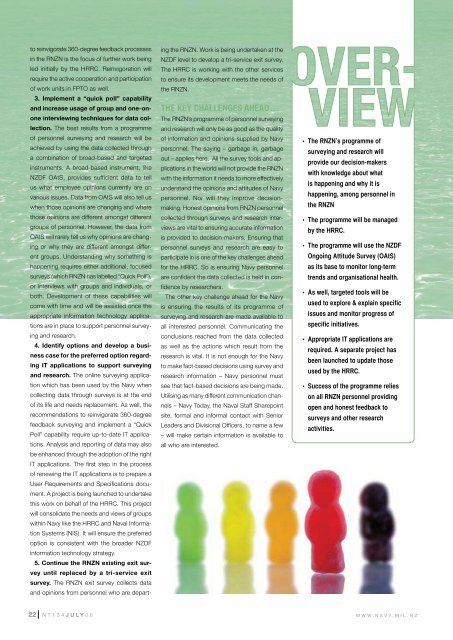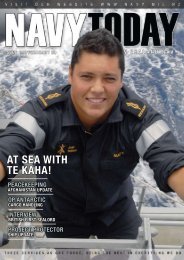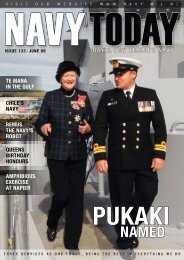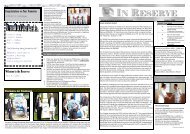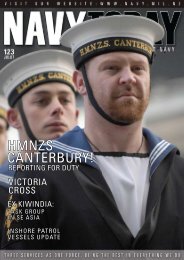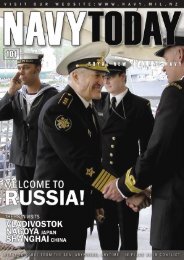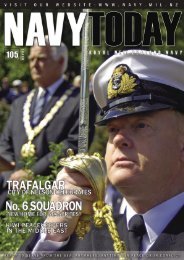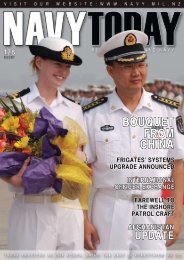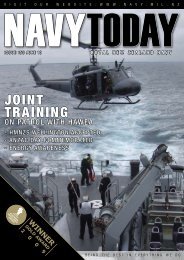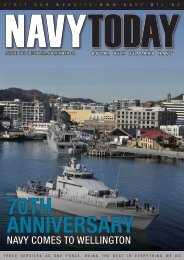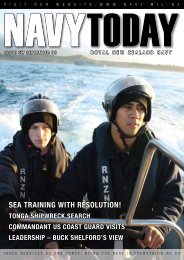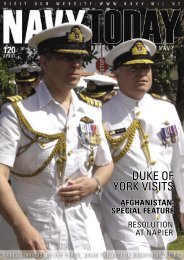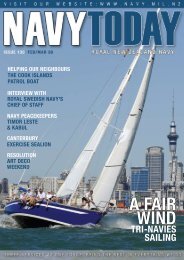Navy Today July 08 | Issue 134 - Royal New Zealand Navy
Navy Today July 08 | Issue 134 - Royal New Zealand Navy
Navy Today July 08 | Issue 134 - Royal New Zealand Navy
- No tags were found...
Create successful ePaper yourself
Turn your PDF publications into a flip-book with our unique Google optimized e-Paper software.
PERSONNELto reinvigorate 360-degree feedback processesin the RNZN is the focus of further work beingled initially by the HRRC. Reinvigoration willrequire the active cooperation and participationof work units in FPTO as well.3. Implement a “quick poll” capabilityand increase usage of group and one-ononeinterviewing techniques for data collection.The best results from a programmeof personnel surveying and research will beachieved by using the data collected througha combination of broad-based and targetedinstruments. A broad-based instrument, likeNZDF OAtS, provides sufficient data to tellus what employee opinions currently are onvarious issues. Data from OAtS will also tell uswhen those opinions are changing and wherethose opinions are different amongst differentgroups of personnel. However, the data fromOAtS will rarely tell us why opinions are changingor why they are different amongst differentgroups. Understanding why something ishappening requires either additional, focusedsurveys (which RNZN has labelled “Quick Poll”),or interviews with groups and individuals, orboth. Development of these capabilities willcome with time and will be assisted once theappropriate information technology applicationsare in place to support personnel surveyingand research.4. Identify options and develop a businesscase for the preferred option regardingIT applications to support surveyingand research. The online surveying applicationwhich has been used by the <strong>Navy</strong> whencollecting data through surveys is at the endof its life and needs replacement. As well, therecommendations to reinvigorate 360-degreefeedback surveying and implement a “QuickPoll” capability require up-to-date IT applications.Analysis and reporting of data may alsobe enhanced through the adoption of the rightIT applications. The first step in the processof renewing the IT applications is to prepare aUser Requirements and Specifications document.A project is being launched to undertakethis work on behalf of the HRRC. This projectwill consolidate the needs and views of groupswithin <strong>Navy</strong> like the HRRC and Naval InformationSystems (NIS). It will ensure the preferredoption is consistent with the broader NZDFinformation technology strategy.5. Continue the RNZN existing exit surveyuntil replaced by a tri-service exitsurvey. The RNZN exit survey collects dataand opinions from personnel who are departingthe RNZN. Work is being undertaken at theNZDF level to develop a tri-service exit survey.The HRRC is working with the other servicesto ensure its development meets the needs ofthe RNZN.The Key Challenges Ahead…The RNZN’s programme of personnel surveyingand research will only be as good as the qualityof information and opinions supplied by <strong>Navy</strong>personnel. The saying – garbage in, garbageout – applies here. All the survey tools and applicationsin the world will not provide the RNZNwith the information it needs to more effectivelyunderstand the opinions and attitudes of <strong>Navy</strong>personnel. Nor will they improve decisionmaking.Honest opinions from RNZN personnelcollected through surveys and research interviewsare vital to ensuring accurate informationis provided to decision-makers. Ensuring thatpersonnel surveys and research are easy toparticipate in is one of the key challenges aheadfor the HRRC. So is ensuring <strong>Navy</strong> personnelare confident the data collected is held in confidenceby researchers.The other key challenge ahead for the <strong>Navy</strong>is ensuring the results of its programme ofsurveying and research are made available toall interested personnel. Communicating theconclusions reached from the data collectedas well as the actions which result from theresearch is vital. It is not enough for the <strong>Navy</strong>to make fact-based decisions using survey andresearch information – <strong>Navy</strong> personnel mustsee that fact-based decisions are being made.Utilising as many different communication channels– <strong>Navy</strong> <strong>Today</strong>, the Naval Staff Sharepointsite, formal and informal contact with SeniorLeaders and Divisional Officers, to name a few– will make certain information is available toall who are interested.• The RNZN’s programme ofsurveying and research willprovide our decision-makerswith knowledge about whatis happening and why it ishappening, among personnel inthe RNZN• The programme will be managedby the HRRC.• The programme will use the NZDFOngoing Attitude Survey (OAtS)as its base to monitor long-termtrends and organisational health.• As well, targeted tools will beused to explore & explain specificissues and monitor progress ofspecific initiatives.• Appropriate IT applications arerequired. A separate project hasbeen launched to update thoseused by the HRRC.• Success of the programme relieson all RNZN personnel providingopen and honest feedback tosurveys and other researchactivities.FROMOUR NEWMILITARYREMUNERATIONSYSTEMBY BRIG MARK WHEELERASSISTANT CHIEF OF PERSONNELTHE NEW MILITARY Remuneration System (MRS)came into effect on 4 <strong>July</strong> 20<strong>08</strong>, and work iscontinuing for full implementation to occur withinthe year - no later than <strong>July</strong> 2009. The MRS is anexciting development in NZDF’s Defence TransformationProgramme.Retaining our highly motivated and capableworkforce is critical to delivery of future capability,and appropriate remuneration is one of the keys tomaintaining this motivation for service.The new Military Remuneration System will rewardour people more effectively, and will put inplace a new system to take us forward into the21st Century with a simpler and better remunerationprocessI believe the MRS will support recruiting bymaking NZDF an organisation of choice, and willWHERE CAN I FIND OUTMORE INFORMATION?Letters: Individual letters have been sent to every uniformed servicepersoninforming you of your Defined TFR. If you have not received a letter pleasecontact your Admin Centre.Intranet site: The MRS site on the Pers Branch Intranet contains backgroundinformation on the system, frequently asked questions, and the newRemuneration tables and sector / tier charts.Admin Centres: Your Admin Centre will be able to answer specific questionson your individual circumstances.Roadshows: An external agency (Mercer) continues to hold financial planningworkshops in all camps and bases throughout the country. This information willalso be available on the Pers Branch Intranet site.Pamphlet: A pamphlet outlining the new MRS is available in every camp andbase.Working for Families: Your new remuneration package may have an impacton the Working for Families tax credits you may have been receiving. Visitwww.workingforfamilies.govt.nz or contact the Ministry of Social Development.(P: <strong>08</strong>00 227 773) for further information.NZDF Superannuation Advice: You can gain more information on the NZDFsuperannuation options by calling Mercer (<strong>08</strong>00 333 787).support retention by removing remuneration as amajor dissatisfier for military personnel.CDF and the Executive Leadership Team havedirected that MRS demonstrates to our people thatwe value your contribution to the NZDF and thatwe will reward this service with appropriate andfair remuneration and conditions of service. CDFand the Chiefs have found the resources to makethe transition to market-indexed remuneration.We now have an annual review mechanism withexternal participation, which means we can remainconfident that we will continue to fairly remunerateour people into the future.MILITARY REMUNERATION SYSTEMThis comprehensive new Military RemunerationSystem:• is a Total Rewards package which recognises allthe rewards that are provided to service personnel;• is fair, transparent, equitable and easier to administer;• is indexed to the wider NZ employment market toenable salary settings to better reflect civil marketand skill relativity;• aids recruitment and retention of personnel;• retains rank as a cornerstone to rewarding personnelfor additional responsibilities, whilst delinkingrank from trade or branch qualifications toenable pay progression not being reliant on rankadvancement;• provides flexibility to reward military personnel inline with their value to the NZDF; and• provides a review mechanism that allows theremuneration processes, systems and benefits toIMPLEMENTATIONremain competitive and attractive.With the implementation of the new Military RemunerationSystem, you now have more choiceabout what you do with your remuneration. Youwill also have confidence that you are being fairlyrewarded for the rank and trade you hold, relativeto the external job market.In a few cases, some may not be on the correctstep during the transition stage. Once the MRS isfully implemented (which will be no later that <strong>July</strong>2009), if you are one of those on an incorrect payrate you will receive back pay to 4 <strong>July</strong> <strong>08</strong> or thedate of occurrence.The combination of Market-aligned remunerationand the premium for service has the effect oflifting Defence remuneration above the majority ofpeople doing similar jobs in the wider NZ employmentmarket.I am confident that now every Service person will:• have choice on how to access and use their totalremuneration,• be treated equitably,• have access to accommodation choices, and• be transparently better off.It is easy to underestimate the significant amountof hard work that has gone into this project, and,while there is still more to do, at this point I wouldlike to acknowledge everyone involved in the developmentand introduction of the new MilitaryRemuneration System. The dedication and commitmentshown by the teams in Personnel Branch,CIS (JAEG), JLSO and Single Service HR departmentshas meant that the NZDF will now have arobust, fair and future-proof solution to addressingremuneration issues.The Military Remuneration System is beingintroduced in three phases:Phase 1: Translation. This is the period leading up 4 <strong>July</strong>. The currentpay of all military personnel will be translated to the Defined Total FixedRemuneration (TFR) which will have the effect of creating a level playing fieldfor accommodation assistance and superannuation across the NZDF. DefinedTFRs have recently been advised to all NZDF service personnel via letter. TheDTFR was effective from 4 Jul <strong>08</strong> and will be paid on 17 Jul <strong>08</strong>.Phase 2: Transition. It will take a period of time to ensure the MRS is beddedin. During transition, a limited number of pay changes will be able to be affectedfor individuals. The intention is to keep transition to the minimum periodpossible. During transition, the criteria for pay progression steps for eachbranch, specialisation and trade will be finalised and the correct pay step for allpersonnel will be identified.Phase 3: MRS Full Implementation. This will occur no later than 1 <strong>July</strong> 2009.Personnel will be placed on appropriate pay progression step and any paychanges that result will be back paid to 4 <strong>July</strong> <strong>08</strong>, or the date of occurrence.22 NT<strong>134</strong>JULY<strong>08</strong> WWW.NAVY.MIL.NZWWW.NAVY.MIL.NZ NT<strong>134</strong>JULY<strong>08</strong> 23


